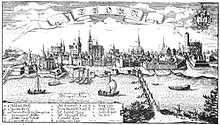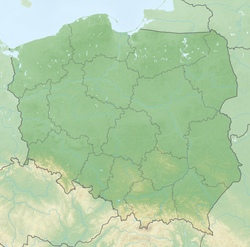Siege of Thorn (1703)

“Prospect from the city of THORN So Anno 1703 in the Majo by Ihro Königl. Mayten from Sweden KING CARL the XII blocquirt "
| date | May 26 - October 14, 1703 |
|---|---|
| place | Thorn , Poland |
| output | Victory of the Swedes |
| consequences | Capture of Thorn |
| Parties to the conflict | |
|---|---|
| Commander | |
|
|
|
| Troop strength | |
| 6,000 men | 26,000 men |
| losses | |
|
4860 prisoners (including the sick), about 1000 dead |
50 dead |
1st phase: Swedish dominance (1700–1709)
Riga I • Jungfernhof • Varja • Pühhajoggi • Narva • Pechora • Düna • Rauge • Erastfer • Hummelshof • Embach • Tartu • Narva II • Wesenberg I • Wesenberg II
Arkhangelsk • Lake Ladoga • Nöteborg • Nyenschanz • Neva • Systerbäck • Petersburg • Vyborg I • Porvoo • Neva II • Koporje II • Kolkanpää
Vilnius • Salads • Jacobstadt • Walled Courtyard • Mitau • Grodno I • Olkieniki • Nyaswisch • Klezk • Ljachavichy
Klissow • Pułtusk • Thorn • Lemberg • Warsaw • Posen • Punitz • Tillendorf • Rakowitz • Praga • Fraustadt • Kalisch
Grodno II • Golovchin • Moljatichi • Rajowka • Lesnaja • Desna • Baturyn • Koniecpol • Weprik • Opischnja • Krasnokutsk • Sokolki • Poltava I • Poltava II
2nd phase: Sweden on the defensive (1710–1721)
Riga II • Vyborg II • Pernau • Kexholm • Reval • Hogland • Pälkäne • Storkyro • Nyslott • Hanko
Helsingborg • Køge Bay • Gulf of Bothnia • Frederikshald I • Dynekilen Fjord • Gothenburg I • Strömstad • Trondheim • Frederikshald II • Marstrand • Ösel • Gothenburg II • Södra Stäket • Grönham • Sundsvall
Elbing • Wismar I • Lübow • Stralsund I • Greifswalder Bodden I • Stade • Rügen • Gadebusch • Altona • Tönning II • Stettin • Fehmarn • Wismar II • Stralsund II • Jasmund • Peenemünde • Greifswalder Bodden II • Stresow
The siege of Thorn took place from May 26 to October 14, 1703 as part of the Great Northern War . The Swedes under King Charles XII. conquered the Thorn fortress , today's Toruń on the Vistula , after months of siege . Thorn was defended by the troops of Augustus the Strong , Elector of Saxony and King of Poland. While the Swedes suffered fewer than 50 men in losses during the siege, the Saxons lost their entire garrison of 6000 men.
prehistory
In 1699 was in Moscow between Tsar Peter I , King August II. Of Poland and Frederick IV. Of Denmark in the Treaty of Preobrazhenskoye District an alliance against the Kingdom of Sweden concluded with the aim of weakening the Swedish position in the Baltic region. The Great Northern War that then broke out, however, developed differently for the alliance than planned. Instead of the hoped-for territorial gains in the Baltic States , the Wettin king of Poland, August II , did not achieve any military successes against King Charles XII. of Sweden . The military situation developed so badly for the alliance that, from 1702, Polish territory immediately became a deployment area and theater of war for Swedish troops. During their advance into the territory of the aristocratic republic , the Swedes received active support from the Polish magnates who were in opposition to King August II.
The garrison Thorns existed at the beginning of the siege of 6000 men, made up of nine incomplete Saxon regiments . The artillery consisted of 43 bronze and 46 iron guns, 5 howitzers and 9 mortars . August II appointed General Christoph Heinrich von Kanitz as the commander . He took precautions to repair the fortifications.
King Charles XII. had before the siege of Thorn on April 21st (swedish) / 1. May 1703 (greg.) Defeated a large Saxon army at the Battle of Pultusk and then marched northwards against the strong fortress itself to destroy the last remnant of the demoralized Saxon army.
course

When the Swedes approached the fortress on May 24th, the garrison set fire to the suburbs. In addition, the armed citizenry was patterned and divided into positions. On May 26, the bulk of the Swedish army, 26,000 strong, arrived in front of the city. The Swedish army pitched camp in front of the Jakobstor and the Treposcher mill on the bank of the Vistula. The Swedish artillery consisted only of light field guns, which were wholly unsuitable for a siege . Charles XII. therefore sent siege artillery from Riga and Karlskrona . Apart from the fact that the Swedes drove the Saxon troops from the vicinity of the Bäckerberg on June 8th, little happened in the first four weeks of siege. The garrison used the relative calm to improve the still imperfect fortifications. At times up to 2000 workers worked on it. The Swedes in turn expected reinforcements by sea via Danzig . The necessary siege artillery was to be brought in in 40 ships. In Thorn, the lack of fresh food and clean drinking water became noticeable in the course of time, so that the Red Ruhr spread quickly in the city, which soon around half of the fortress garrison was canceled. In mid-September the siege work of the Swedes accelerated, who built a second bridge below Thorn over the Vistula and set up two batteries within firing range. A defeat from Thorn against the entrenchment work of the besiegers on September 22nd could be repulsed by the Swedes after initial Saxon successes. The plan to relieve the beleaguered city by a Polish-Saxon troop was not carried out because there were delays in the execution of the decisions of the Sejm on the formation of troops.
On September 24th the bombing of the Swedes began. Shortly afterwards, fires broke out in five locations in the city. The Swedish trenches were driven further up to the range of the walls. Defectors told the Swedes about the rapidly deteriorating conditions in the city. Due to the ongoing bombing, the citizens demanded that the city be surrendered to the Swedes, but the commandant refused. The garrison is said to have only 1,300–1600 men of military age at the time. Negotiations began on October 7th about the city's handover conditions. On Sunday, October 14th, the Swedes were given the Kulmer Gate, which they occupied with 600 men. With the exception of the officers, the Saxon troops were disarmed. The men of the captured Saxon garrison of 4,860 men, almost 3,000 of whom were sick, were chained together in pairs and brought to Sweden via Danzig at the city's expense. The Swedes made rich booty of war material in the city. They captured 96 artillery pieces, 9 mortars, 30 field snakes , 8,000 muskets with 276,000 musket balls and 800 hundredweight of powder.
consequences
Not only did the town's fortifications suffer severe damage from the bombardment, but also their houses. The old town hall was burned out as a result of the bombardment, as was almost the entire west side of the old town market and other houses. Numerous other buildings were damaged, some of them badly. Together with the contributions to be paid several times in the following years and a plague epidemic in the years 1708 to 1709, this war damage impoverished the city for a long time. For this reason, for example, the restoration work on the town hall dragged on until 1737.
After the capture of Thorn there were no more Saxon troops in Poland for the time being, the country was completely under the control of King Charles XII. and his Polish followers. So that this city, which had resisted the Swedes for half a year, would no longer be able to offer resistance, its fortifications were razed. This procedure also corresponded to Charles XII's strategy of “neutralizing” fortress cities by rendering their fortifications unusable in order not to have to occupy them with their own troops. He was aware of the superiority of his army and sought the decision in open battle, which is why he could not and could not afford to weaken his armed forces by surrendering garrisons. On November 21st, the Swedes left Thorn for Elblag . Because of his war fame, the Charles XII. hurried ahead, but also deterred by the example of Thorn, many other cities submitted to the King of Sweden and were spared in return for paying high tributes.
literature
- Antoni Czacharowski (Ed.): Atlas historyczny miast Polskich. Tom 1: Prusy Królewskie i Warmia, zeszyt 2: Toruń. Uniw. Mikołaja Kopernika 1995, ISBN 83-231-0664-9 .
- Karl Hoburg: The sieges of the city and fortress Thorn since the 17th century , Lambeck Verlag, Thorn 1844.
- Anders Fryxell: Life story of Karl the Twelfth, King of Sweden, Volume 1, Braunschweig 1861.
- Robert I. Frost: The Northern Wars. War, State and Society in Northeastern Europe, 1558-1721 (= Modern Wars in Perspective). Harlow 2000, ISBN 978-0-582-06429-4 .
Individual evidence
- ↑ Tony Jaques: Dictionary of Battles an Sieges: A Guide to 8,500 Battles from Antiquity, p. 1014
- ↑ See Robert I. Frost: The Northern Wars , p. 263ff
- ↑ in: Karl Hoburg: The sieges of the city and fortress Thorn since the 17th century, p. 52 are named in detail: 2 generals, 283 officers, 5584 NCOs and commons
- ↑ Anders Fryxell: Life story of Karl the Twelfth, King of Sweden, Volume 1, p. 184
- ^ Karl Hoburg: The sieges of the city and fortress Thorn since the 17th century, p. 53
- ^ Karl Hoburg: The sieges of the city and fortress Thorn since the 17th century, p. 55
- ^ Robert I. Frost: The Northern Wars , p. 267
- ↑ Anders Fryxell: Life story of Karl the Twelfth, King of Sweden, Volume 1, p. 188
- ^ Karl Hoburg: The sieges of the city and fortress Thorn since the 17th century, p. 65
- ↑ Antoni Czacharowski: Atlas historyczny miast Polskich. Tom 1: Prusy Królewskie i Warmia, zeszyt 2: Toruń, p. 17.
- ↑ See Robert I. Frost: The Northern Wars , p. 283

